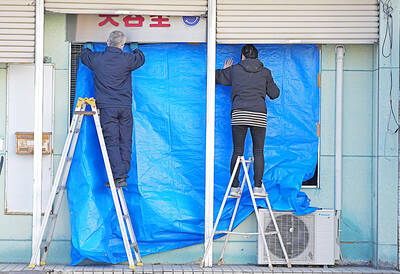Taiwan is likely to face an increasing number of challenges in deterring threats from China after the People’s Liberation Army (PLA) yesterday launched four days of live-fire military exercises surrounding the nation, military experts told a panel in Taipei.
The panel, organized by the Institute for National Policy Research, addressed issues that the nation could encounter in the next few weeks following a 19-hour visit by US House of Representatives Speaker Nancy Pelosi, which ended on Wednesday.
Beijing in response launched a series of retaliatory actions, including live-fire naval drills in six zones surrounding Taiwan, on the grounds that Pelosi’s visit “violated the ‘one China’ principle stated in the Joint Three Communiques between the US and China.”

Photo: Lo Pei-te, Taipei Times
“The Chinese military exercises will completely nullify a tacit agreement between Taiwan and China that both should avoid engaging in military activities around the median line of the Taiwan Strait,” said Ma Chen-kun (馬振坤), director of National Defense University’s Graduate Institute of China Military Affairs Studies.
“More military aircraft and vessels are expected to cross the median line and operate close to the fringes of our airspace and territorial waters, leaving us with little room to employ ‘deep defense’ strategies,” Ma said.
In addition to developing asymmetric warfare capabilities, Taiwan needs to maintain a certain scale of basic combat power, he said.
“Unlike Ukraine, Taiwan is surrounded by sea, and it is absolutely crucial that we maintain a dependable naval and air combat power, and the ability to strike outside the line of sight, which is key in avoiding a blockade by the PLA,” Ma said.
Ma said that China claimed that live-fire military exercises off Taiwan’s north, southwest and southeast coasts were designed to test its joint combat capability as well as the performance of its weaponry.
The drill zones were chosen to test different military capabilities, showing a basic plan that the PLA could adopt if China were to attack Taiwan, Ma said.
“They have stated the purposes of the drills, and the goals they want to achieve, but whether they are capable of accomplishing them would have to be assessed by action plans they set for the drills. So far, we cannot make any assessment in that regard,” he said.
However, Beijing would pay a considerable price if it attacks Taiwan given Taiwan’s capabilities in air defense, sea control and other operations, Ma said.
Last month, Chinese People’s Political Consultative Conference Chairman Wang Yang (汪洋) said that Beijing prefers unification with Taiwan by peaceful means.
“Wang’s statement showed that China has no intention of turning military exercises into an actual war with Taiwan. The drills are purely militaristic reactions to Pelosi’s visit to Taiwan,” Ma said.
While China’s military actions could be used to attempt an economic blockade of Taiwan, it in fact would block access to its own air and sea routes, as well as those of other countries, Institute of National Defense and Security Research research fellow Su Tzu-yun (蘇紫雲) said.
“The Taipei Flight Information Zone is accessed by 1.7 million commercial jets per year, and the Taiwan Strait is a passage to the South China Sea, through which US$5.3 trillion worth of goods transits annually. The sea route is a lifeline to China, Taiwan, Japan and South Korea,” Su said.
“As China has 60 percent of its trade in value traveling by sea, a blockade in the Taiwan Strait would affect China and the globe, and result in higher premiums for war-risk insurance and further disruptions of supply chains. Making it a long-term practice would be difficult,” he said.
Taiwan made the right decision to keep a low profile for Pelosi’s visit, as it helped win support from the international community and highlighted China as a troublemaker, Su said, adding that the government needs a better strategy to address diplomatic predicaments facing the nation.
“The best and most urgent solution is to increase defense spending, which boosts Taiwan’s defense capability, diplomatic weight and economy,” he said.
As trust between the Washington and Beijing is expected to drop significantly following Pelosi’s visit, the US is likely to work toward avoiding military conflicts with China, Institute for National Policy Research executive director Kuo Yu-jen (郭育仁) said.
Taiwan is expected to have an increased number of military exchanges with the US, Japan and the Philippines, as China intensifies its efforts to isolate Taiwan militarily, economically and politically following the 20th Chinese Communist Party Congress later this year, Kuo said.

Taiwanese were praised for their composure after a video filmed by Taiwanese tourists capturing the moment a magnitude 7.5 earthquake struck Japan’s Aomori Prefecture went viral on social media. The video shows a hotel room shaking violently amid Monday’s quake, with objects falling to the ground. Two Taiwanese began filming with their mobile phones, while two others held the sides of a TV to prevent it from falling. When the shaking stopped, the pair calmly took down the TV and laid it flat on a tatami mat, the video shows. The video also captured the group talking about the safety of their companions bathing

US climber Alex Honnold is to attempt to scale Taipei 101 without a rope and harness in a live Netflix special on Jan. 24, the streaming platform announced on Wednesday. Accounting for the time difference, the two-hour broadcast of Honnold’s climb, called Skyscraper Live, is to air on Jan. 23 in the US, Netflix said in a statement. Honnold, 40, was the first person ever to free solo climb the 900m El Capitan rock formation in Yosemite National Park — a feat that was recorded and later made into the 2018 documentary film Free Solo. Netflix previewed Skyscraper Live in October, after videos

Starting on Jan. 1, YouBike riders must have insurance to use the service, and a six-month trial of NT$5 coupons under certain conditions would be implemented to balance bike shortages, a joint statement from transportation departments across Taipei, New Taipei City and Taoyuan announced yesterday. The rental bike system operator said that coupons would be offered to riders to rent bikes from full stations, for riders who take out an electric-assisted bike from a full station, and for riders who return a bike to an empty station. All riders with YouBike accounts are automatically eligible for the program, and each membership account

A classified Pentagon-produced, multiyear assessment — the Overmatch brief — highlighted unreported Chinese capabilities to destroy US military assets and identified US supply chain choke points, painting a disturbing picture of waning US military might, a New York Times editorial published on Monday said. US Secretary of Defense Pete Hegseth’s comments in November last year that “we lose every time” in Pentagon-conducted war games pitting the US against China further highlighted the uncertainty about the US’ capability to intervene in the event of a Chinese invasion of Taiwan. “It shows the Pentagon’s overreliance on expensive, vulnerable weapons as adversaries field cheap, technologically